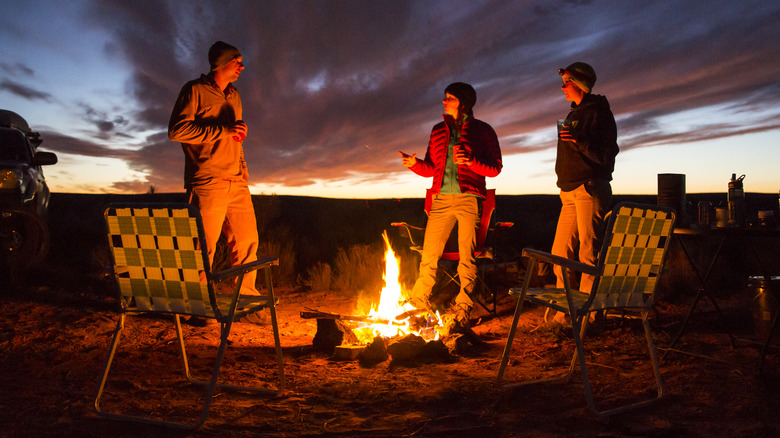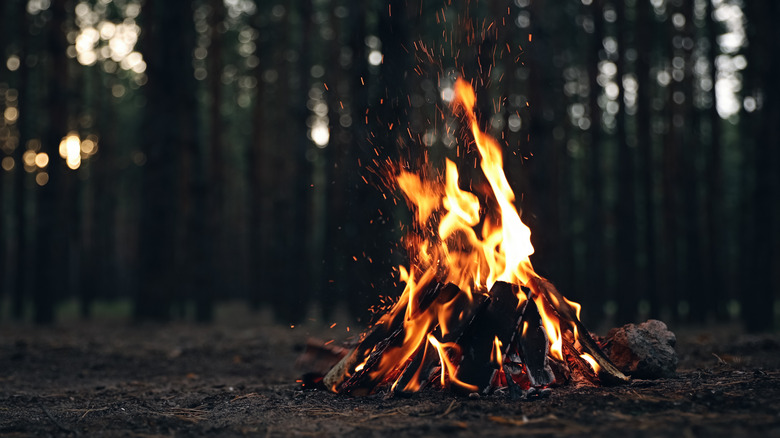The Best Types Of Wood To Use For Campfires
Regardless of the time of year, building the perfect campfire is an essential part of the camping experience for almost everyone who spends the night outdoors. Whether it will be used for cooking tasty campfire meals, providing warmth on a chilly night, or simply to provide ambiance for a fireside gathering, the camping experience feels a bit incomplete without a decent blaze burning. In their minds, campers typically picture an idyllic, romanticized version of a crackling fire surrounded by happy friends and family. Unfortunately, far too often the reality is more of a smoldering, smokey mess that is a chore to keep lit. The reason for this is the wrong type of wood was chosen to fuel the fire.
While it is discouraged -– and even illegal in many states –- to transport firewood more than a short distance, that doesn't mean you must settle for subpar wood for your fire. Most areas are populated by a variety of trees. So, while there are rare instances when you have to settle for whatever you can find, knowing which ones start fastest, burn the cleanest, and last the longest will help you choose the best types of wood to use for your campfires.
Best wood for starting a campfire
Starting a campfire and keeping a campfire burning are two different things. Ideally, you will be able to use different woods for each task, as some of the best woods for starting a fire aren't necessarily the best for burning on a campfire once it's going strong. To that end, while there are several hacks for starting campfires, there are plenty of natural fire starters that can be gathered. While any sort of small, dry stick can be used for kindling, some are better than others. In general, any type of conifer will burn very easily. This means pines and firs make ideal kindling. Cedars are another good option.
The reason these woods light quickly is they are soft and full of resin, which is extremely flammable. In fact, the absolute best natural fire starters are resin-laden pieces of pine known as fatwood. However, whether you use fatwood to build a campfire or just a pile of pine or fir, the same characteristics which cause them to light easily also make them poor choices for main firewood, as they burn too fast and generally give off too much smoke and soot. As a result, a campfire filled with pine wood will be hard to maintain, be too smokey to comfortably stand near, and will taint the flavor of any meal you attempt to cook. The exception to this is cedar, which unlike other conifers, typically makes a decent main firewood. So, once the fire is going, you should switch over to another type of wood to maintain it.
Best wood to burn on a campfire
When it comes to main wood for your campfire, your selection will typically be dictated by the region in which you are camping. However, as a rule, hardwoods make better campfires. So, try to select pieces of whichever hardwood is most prevalent. If you have more than one to choose from, you may be able to carefully select the best quality. Some examples of woods considered to be among the best for campfires are ash, apple, beech, cedar, and hickory. Slightly lower on the scale are woods such as birch, maple, oak, and pecan. Additionally, if you are planning to cook, you may choose to pick woods specifically for that purpose. Among those considered the best for cooking are apple, cherry, hickory, mesquite, oak, and pecan.
No matter the variety of main wood you choose, be sure to gather pieces of wood that are in good condition for burning. Wet wood, whether saturated with rainwater or because it is freshly cut, will not burn efficiently. Conversely, wood that is starting to rot will burn too fast. Instead, try to find dead wood that has dried so that it's hardened. The inner rings of such a piece of wood will appear to be darkened. Additionally, any time you have a campfire burning, be sure to follow Smokey Bear's advice to avoid starting a wildfire.


